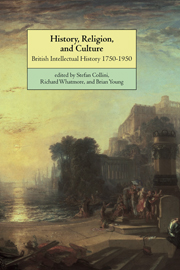Book contents
- Frontmatter
- Contents
- Preface
- General introduction
- Presentation of History, Religion, and Culture
- Part I
- Part II
- 4 ‘The Lust of Empire and Religious Hate’: Christianity, history, and India, 1790–1820
- 5 The Victorians and Oliver Cromwell
- 6 Religion and politics in the Quarterly Review, 1809–1853
- 7 Ruskin's way: tout à fait comme un oiseau
- Part III
- List of contributors
- Acknowledgements
- Index
4 - ‘The Lust of Empire and Religious Hate’: Christianity, history, and India, 1790–1820
Published online by Cambridge University Press: 03 December 2009
- Frontmatter
- Contents
- Preface
- General introduction
- Presentation of History, Religion, and Culture
- Part I
- Part II
- 4 ‘The Lust of Empire and Religious Hate’: Christianity, history, and India, 1790–1820
- 5 The Victorians and Oliver Cromwell
- 6 Religion and politics in the Quarterly Review, 1809–1853
- 7 Ruskin's way: tout à fait comme un oiseau
- Part III
- List of contributors
- Acknowledgements
- Index
Summary
And have the purveyors of imperial lust
Torn from their parents' arms again
The virgin beauties of the land?
Robert Southey, Thalaba the DestroyerOn 18 June 1822, the Sixteenth, the Queen's Light Dragoons, set sail for Calcutta on board The Marchioness of Ely. The officers of the regiment discovered a favoured book during the voyage, the recently published Ivanhoe, for sometime either in December 1822 or January 1823 an Ivanhoe party was held in their honour at Calcutta. One of the party, a Captain Luard, with all the attainments expected of a young officer of the day, not only played his part in the arrangements, but also completed a sketch of the assembled dignitaries and their ladies, dressed as the leading figures in the novel. It should not come as too much of a surprise that imaginative literature played so strong a role in the formation of the minds of those obliged to make the long journey to India. Aside from a slowly emerging literature on India, there was little for such people, soldiers, civil servants, or clergy, to draw upon in addressing this forbiddingly ‘other’ culture. When confronted by the ululations of Hindu women at the shrine of Juggernaut in Orissa in 1806, Claudius Buchanan, the evangelical vice-president of Fort William College at Calcutta, similarly took refuge behind Milton's depiction of Pandemonium in attempting to convey his extreme sense of religious disorientation. It was, then, to comfortingly familiar literature that the British in India, like the Spanish in America, were obliged to return when trying to make sense of this new old world.
- Type
- Chapter
- Information
- History, Religion, and CultureBritish Intellectual History 1750–1950, pp. 91 - 111Publisher: Cambridge University PressPrint publication year: 2000
- 3
- Cited by



